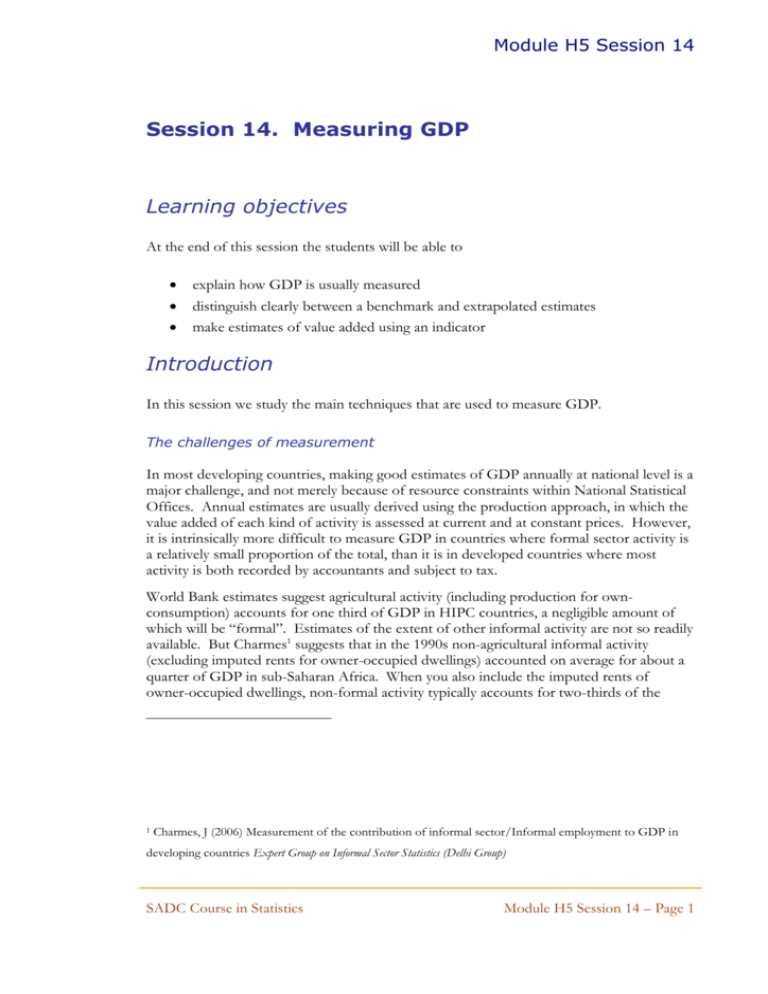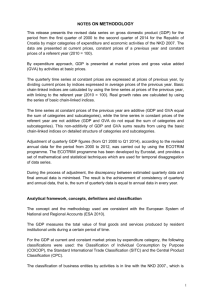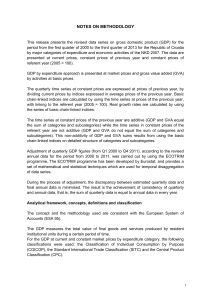Session 14. Measuring GDP
advertisement

Module H5 Session 14 Session 14. Measuring GDP Learning objectives At the end of this session the students will be able to explain how GDP is usually measured distinguish clearly between a benchmark and extrapolated estimates make estimates of value added using an indicator Introduction In this session we study the main techniques that are used to measure GDP. The challenges of measurement In most developing countries, making good estimates of GDP annually at national level is a major challenge, and not merely because of resource constraints within National Statistical Offices. Annual estimates are usually derived using the production approach, in which the value added of each kind of activity is assessed at current and at constant prices. However, it is intrinsically more difficult to measure GDP in countries where formal sector activity is a relatively small proportion of the total, than it is in developed countries where most activity is both recorded by accountants and subject to tax. World Bank estimates suggest agricultural activity (including production for ownconsumption) accounts for one third of GDP in HIPC countries, a negligible amount of which will be “formal”. Estimates of the extent of other informal activity are not so readily available. But Charmes1 suggests that in the 1990s non-agricultural informal activity (excluding imputed rents for owner-occupied dwellings) accounted on average for about a quarter of GDP in sub-Saharan Africa. When you also include the imputed rents of owner-occupied dwellings, non-formal activity typically accounts for two-thirds of the 1 Charmes, J (2006) Measurement of the contribution of informal sector/Informal employment to GDP in developing countries Expert Group on Informal Sector Statistics (Delhi Group) SADC Course in Statistics Module H5 Session 14 – Page 1 Module H5 Session 14 economy. Formal activity (including government and taxes on products) accounts for the remaining third. Thus for two-thirds of the economy, no accounting data are available; so estimates are based on – what exactly? Before answering this question we review the main approaches to measuring GDP The traditional methods… Traditionally, three main approaches to measuring GDP are referred to. These are the output (or production) approach, the income approach and the expenditure approach. The first two of these approaches are closely linked. Theoretically they both aim to measure the gross value added (GVA) broadly in terms of a business profit and loss account either from the top down (output) or the bottom up (income). In the output approach, the value of total output is measured and the cost of inputs (intermediate consumption) is subtracted to obtain the GVA. This is done at current and at constant prices, and very often the cost of inputs is assumed to be a given proportion (called the input-output ratio) of the total output, depending on the kind of activity. In the income approach, which is only possible at current prices, GVA is basically obtained by adding the compensation of employees to the gross mixed income or gross operating surpluses of producers. However the income approach is not really feasible in a country where most enterprises are informal, because no direct information is available either on their operating surpluses in total or on how much they are paying their employees. Even for formal enterprises, the information needed to make direct estimates of gross operating surplus may not be readily available. The expenditure approach is completely different. It aims to measure GDP by aggregating final consumption expenditures (by households, NGOs and government), capital formation, and exports less imports of goods and services. The problem is that, in SADC countries, no direct information is available on household expenditure every year, so it is not normally possible to prepare regular direct estimates of GDP according to the expenditure approach. The best source of household expenditure data is a household expenditure survey, but such surveys are not usually conducted every year, in other words continuously. In SADC countries therefore, annual estimates of GDP and the activity components are generally compiled using the production approach. Direct annual estimates are also available for some of the expenditure components. The “commodity flow” method is usually used to estimate fixed capital formation. Changes in inventories may not be covered in full. Final consumption expenditure of households is usually calculated by subtraction as a residual. … and an integrated approach While the traditional approaches may be used to make early estimates for recent years or quarters, the best approach of all to measuring GDP is to compile a Supply-Use Table (SUT). An SUT integrates all three traditional approaches in a comprehensive framework, SADC Course in Statistics Module H5 Session 14 – Page 2 Module H5 Session 14 usually incorporating a form of input-output matrix. This will be covered in more detail in a later session, but in essence it involves compiling statistics on both the supply (the first row of the SNA diagram in session 10) and the demand (the second row) for a detailed list of products or groups of products. A key requirement, among others, is detailed information on household final consumption expenditure. If a household expenditure survey (HES) has been conducted in a particular year, compilers of GDP could and should compile an SUT and thus a benchmark estimate of GDP for the year. Thereafter, the SUT could be updated every year, estimating consumption by commodity flow methods, or by means of more frequent HESs.. Benchmark estimates This is an extract from international guidelines: Benchmark compilations The purpose of the preparation of benchmark estimates is twofold: (a) They provide the most detailed compilation of the national accounts based on large representative censuses and surveys, and, as such, the most detailed description of the structure of an economy; (b) They form the base year to which the consecutive recurrent annual compilations at current and constant prices are linked. The benchmark compilations could be carried out in a long-term cycle with 5- to 10-year intervals. Rebasing of the base year is [warranted if structural changes occur in relative prices, behaviour and/or changes in technology]. However, with a normal pace of economic development, the convention of the preparation of benchmark estimates in a 10-year interval may suffice. Baseline inquiries supporting the preparation of benchmark estimates for enterprises are characterized by their infrequent nature in a decennial or quinquennial cycle, and their comprehensiveness in terms of data items collected and coverage of enterprises across size (including unincorporated enterprises) and kind of economic activity. Reasoning along similar lines, a long-term cycle of household inquiries could be adopted consisting of a long questionnaire form and a more comprehensive geographical representation for the baseline exercise, interspersed with a short-term cycle of data compilation on households, using a short questionnaire form and based on a less comprehensive geographical representation of households. Similarly, administrative records for other sectors, such as government and financial corporations, may also be examined in more detail for benchmark periods than for recurrent compilations, not because the data are not available, but in order to save resources. Source: United Nations A Systems Approach To National Accounts Compilation §§ 244-246 Discussion point What is the “normal pace of economic development”? Does it apply in your country? SADC Course in Statistics Module H5 Session 14 – Page 3 Module H5 Session 14 Measuring GDP annually (and quarterly) Users of GDP estimates want to know as quickly as possible after the end of each period (year or quarter) what GDP was in that period. This requirement for timely estimates drives the methods that are appropriate for making them, at least in the first instance. This is the case in every country. Readily available indicators of economic activity (total output) in each industrial sector or sub-sector are therefore essential in any country. With appropriate assumptions, the indicators can be used to extrapolate the more soundly based benchmark estimates of a previous year. Only in rare cases will full accounting data be available quickly enough to make direct estimates. The precise methods of extrapolation may vary, although methods that appear to differ may often lead to the same result. The method is described here involves extrapolating the benchmark estimates of production using two types of indices derived from the indicators of total output. These are value indices (for current price estimates) and quantity indices (for constant price estimates). In most cases, in order to calculate one or other of these indices, an appropriate price index is needed. For extrapolation purposes, all these indices would be set equal to 100 in the base year. There are two main ways of estimating the value indices on an annual (or quarterly) basis, and three main ways of compiling quantity indices, as follows: Value indices (for current prices) 1. If estimates of the turnover of all the producers in an industrial sector or sub-sector are available directly, these can be used as an estimate of total output at current prices, or converted into an index to extrapolate the benchmark. In general, such data will not be regularly available for informal production, but for those enterprises registered as VAT traders monthly estimates could be available from the Revenue Authority. 2. If turnover estimates are not available directly, a value index can be obtained by multiplying a quantity index by an appropriate price index. In each sector this indicator can be used to extrapolate the benchmark GVA. The assumption is that the input-output ratio remains constant. Quantity indices (for constant prices) 1. If a value index is available directly (case 1 above), a quantity index can be derived by dividing the value index by an appropriate price index. (This method should be used wherever possible, according to the SNA93, but it will not work well in cases of hyper-inflation.) 2. If estimates of quantities produced are available, they can be converted into an index number (weighted together if necessary). There is a danger with this method: if new products are not included, a downward bias can result. SADC Course in Statistics Module H5 Session 14 – Page 4 Module H5 Session 14 3. If neither values nor reliable quantities are available, proxy indicators of quantity may have to be used. For example in some cases the quantity indices are based on the estimated growth rate of the population of the country. Again the usual assumption is that the input-output ratio remains fixed, so the indicator can be applied to the benchmark GVA. Appropriate price indices Ideally the price indices used in these calculations will reflect changes in the basic price of the particular goods or services in question. For agriculture, the (wholesale, if available) prices in local markets are accepted as reflecting movements in basic “farm-gate” prices. For manufacturing activities, producer price indices (PPIs) are the best. For service activities, specific components of the CPI are often the most appropriate, since there is usually little difference between the consumer price and the basic price. In some cases, the all items CPI is the most appropriate available index. Typical sources of data for each kind of activity are described in the Annex. Exercise 1 The table below shows the consumption of cement in Tanzania (obtained by measuring production, adding imports and subtracting exports. The task is to use these data as an indicator of modern construction sector output (excluding the building of traditional dwellings) for estimating the value added of the sub-sector at constant 2001 prices. This can be done in two steps. First calculate the quantity index. Then use this to extrapolate the base year 2001 GVA figure of 379 bn TShs. Calculate the annual percentage changes. Calculation of GVA at constant prices Year Cement consumption ’000 mt 1999 815 2000 808 Quantity index 2001=100 GVA at constant prices Annual changes per cent % 2001 903 2002 1138 100.0 379 % % 2003 1318 % 2004 1368 % 2005 1455 % Source NBS Tanzania SADC Course in Statistics Module H5 Session 14 – Page 5 Module H5 Session 14 Annex to Session 14 Indicators of production by kind of activity For major crops (these may vary from country to country), the source of information is often administrative: either crop forecasts prepared by the Ministry of Agriculture or postharvest assessments made by agricultural extension staff. Some countries undertake regular post-harvest surveys. Reliable estimates of minor crops are unlikely to be available (unless exported), so benchmark estimates may be projected using an indicator such as the total population. For crops that end up as exports, often through some (formal sector) processing or marketing organisation, production estimates will be derived from the external trade data or from the organisation involved. Informal cross-border trade that escapes Customs documentation presents a challenge. Only regular surveys at border crossings are likely capture variations in the quantity of such trade when supply in one country can meet demand in another. Measuring livestock production is another difficult area, although not nearly as important as in value terms as crops. Cattle are frequently seen by their owners as a store of value rather than as a source of income from slaughtering. Censuses of livestock are rare and holders (who first have to be identified) are often shy of revealing how many they have. From time to time vaccination campaigns may provide a handle on the likely numbers, but rarely would these exercises be country wide. Estimates of the production of meat and other products are usually based on assumptions about population growth and off-take rates that may date back several years They may not take account of the effects of drought or disease. And any revision to the figures may cause a sudden jump in the estimates, rather than indicating any real trend in productivity. For forestry, data on logging and the management of public plantations may be obtained from records kept by the Government Department responsible, but estimates of informal (or own account) production of fuel – the collection of firewood for household use and its processing into charcoal – may be only guesses or missing altogether. Information on the multitude of “other forest products” used by rural households is usually only available from ad hoc surveys or intermittent Living Standards Measurement Surveys (LSMS) and estimates are likely to be extrapolated using population growth rates. Similar sources are used for fresh water fishing. Marine fishing often has a government body that is responsible for it and so may be able to provide data. For the mining/petroleum industries, the major companies or the Government Department responsible (perhaps for monitoring royalty payments) is the usual source. Informal production is unlikely to be properly covered, especially if exports go unrecorded. Estimates of manufacturing are very likely to be based on the Index of Industrial Production (IIP). The IIP is likely to be limited in coverage to the largest enterprises and may suffer from the problem of not incorporating new enterprises or products (see Session 5). Assumptions have to be made about the growth of the informal sector. SADC Course in Statistics Module H5 Session 14 – Page 6 Module H5 Session 14 Data on production and distribution of electricity and water come from the utility companies, though this may not included informal or own account activity. Because it is difficult to obtain reliable data on construction activity, estimates of construction output are usually based on the supply of construction materials (particularly cement). For wholesale and retail trade, the total output is not the turnover but the margins charged on the traded goods, in other words the value of sales minus the cost of purchasing the goods sold. The usual method is to apply assumed trade margins to the estimates of imports and of marketed local production. In Francophone countries, use may be made of the DSF for formal activity, but in this sector most of the value added is likely to be informal. Road transport is another difficult to measure sector, although indicators based on vehicle licensing and/or fuel consumption are likely to be better than nothing. For the remaining services activity (apart from government) the estimates are likely to be weak, except where there are reasonable indicators available (hotel occupancy, air-time, school enrolment) or where VAT turnover data exist (for formal activity). These sources may be supplemented by accounting data from the largest companies involved in air transport, communication and financial services. In the case of government activity, total output is computed as intermediate consumption plus compensation of employees plus (in principle) capital consumption, based on government accounting data; one or two countries may include rough estimates of capital consumption. Input-output ratios Except where accounting data are available, input-output ratios are mostly assumed to remain constant from one year to the next. This is a reasonable assumption, at least at constant prices, where the quantity of output is proportional to the quantity of input, as in the conversion of grain into flour, although it can be misleading in specific areas such as agriculture where environmental factors play a big role in determining output. At current prices, this assumption is less reasonable, but commonly made, for example by using a single price index for inflating a constant price indicator of value added. The implicit assumption is that margins are fixed and changes in the price of outputs are determined by changes in the price of inputs rather than by changes in the level of demand. SADC Course in Statistics Module H5 Session 14 – Page 7











